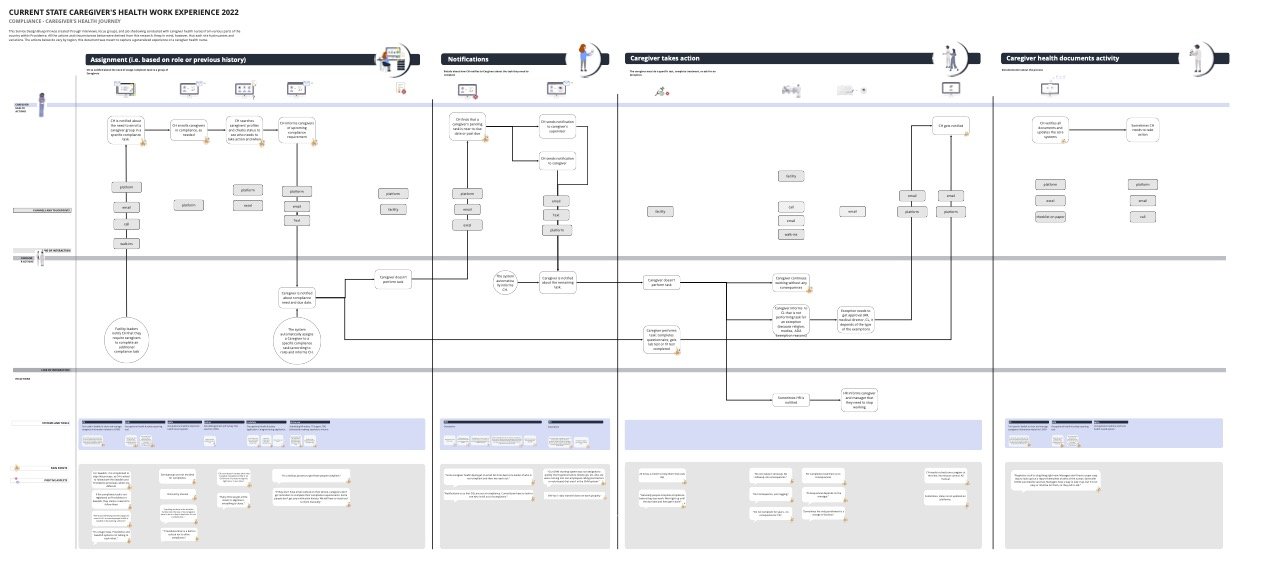Caring for Caregivers
Providence Hospital Network is a large healthcare provider with several locations across the United States. As a consultant for the hospital network's technology innovation team, my role was to help as part of the Caregiver Health Modernization Initiative.
The project was aimed at improving the user experience of the hospital's digital platforms, including their electronic health record system, patient portal, and mobile app. The goal was to make it easier for hospital staff and patients to access and manage health information, resulting in better patient outcomes and higher staff productivity.
Focus
Web/Mobile research
Client
Providence
Team
Admin technology
Role
UX Research Lead
COLLABORATORS I served as the only researcher on the hospital network's technology innovation team. I collaborated closely with the principal designer and cross-functional partners such as business analysts, engineers, and program managers. We worked together to ensure that the research findings aligned with the hospital network's goals and objectives.
TIMELINE The consultation lasted for 10 months, during which we conducted extensive user research to gain insights into the experiences of patients and hospital workers.
RESEARCH GOALS Our primary goal was to uncover the pain points and opportunities for improvement within the hospital network's services and technology. We aimed to develop and test concepts aimed at improving the experience of patients and hospital workers.
RESEARCH METHODS We used a mix of generative research, iterative research, and evaluative research to gain insights into the user experience. The research methods included:
Semi-Structured Exploratory Interviews: I conducted 60-minute interviews with hospital workers and patients to gather insights into their experiences, pain points, and needs. We used a semi-structured approach to allow participants to share their thoughts and experiences in their own words.
Concept Tests: I also conducted concept tests to evaluate the viability of the new concepts and identify any potential issues or barriers to adoption.
Usability Studies: I conducted frequent usability studies to evaluate the experience of all the products supported.
Heuristic Evaluation: I conducted Heuristic Evaluations on all product areas to easily identify areas of improvement based on established design heuristics leading to actionable tickets for design improvements.
Service Blueprints
Personas
FINDINGS & RECOMMENDATIONS Through our research, we uncovered several pain points and opportunities for improvement within the hospital network's services and technology. Some of our key findings and recommendations included:
Improving Communication: Hospital workers and patients expressed frustration with the lack of clear communication between different departments and healthcare providers. We recommended implementing a more streamlined communication system to improve patient outcomes and satisfaction.
Streamlining Processes: Hospital workers reported spending significant amounts of time on administrative tasks, which took away from patient care. We recommended automating administrative tasks where possible to free up more time for patient care.
Improving Patient Education: Patients expressed a desire for more information and education about their health and treatment options. We recommended providing more resources and education to patients to help them make informed decisions about their health.
IMPACT The new digital platforms have had a significant impact on both staff and patients within the hospital network. Staff productivity has increased, as they are now able to more efficiently access and manage patient information. Patients are also more satisfied with their experience, as they are now able to easily access and manage their health information online and through the mobile app. The service blueprint has helped the hospital identify key touchpoints and optimize the user experience across all channels, resulting in improved patient outcomes and a more efficient hospital system.
CONCLUSION Through our user experience research, we were able to identify several pain points and opportunities for improvement within the hospital network's services and technology. Our findings and recommendations were used to inform the development of new concepts and product roadmaps aimed at improving the experience of patients and hospital workers. Overall, our research helped the hospital network better understand the needs and expectations of its users, and provided actionable insights to drive meaningful change.









